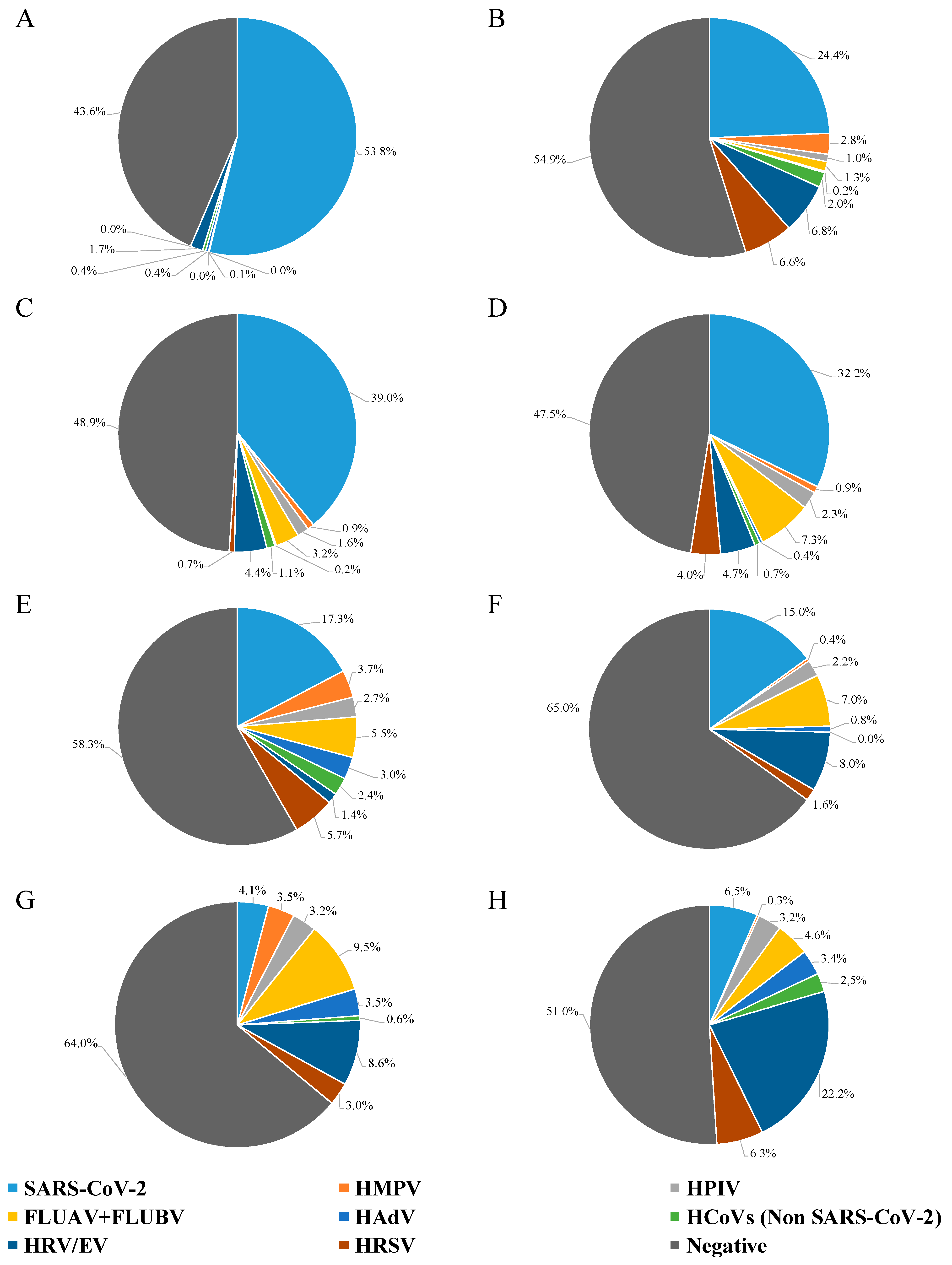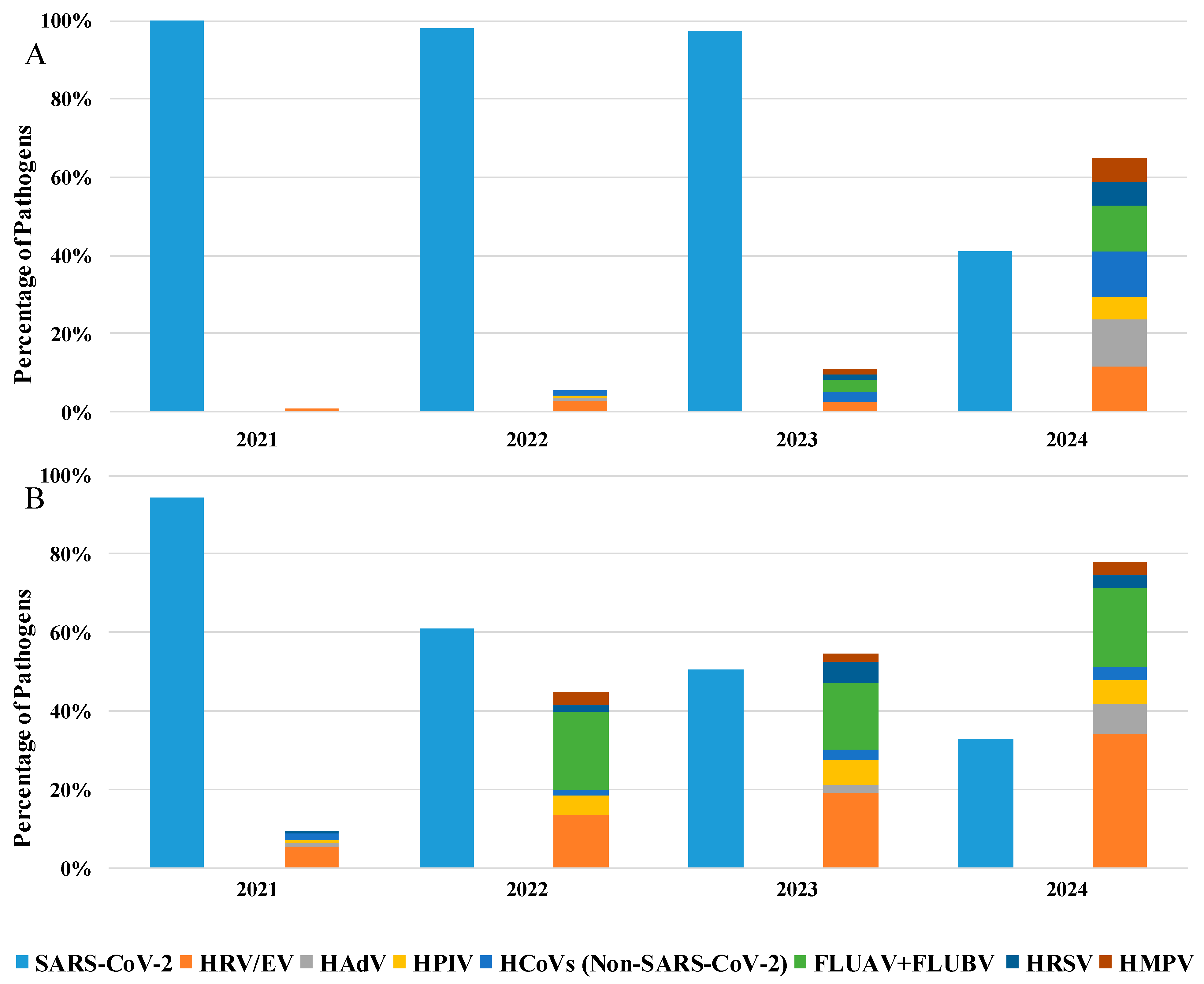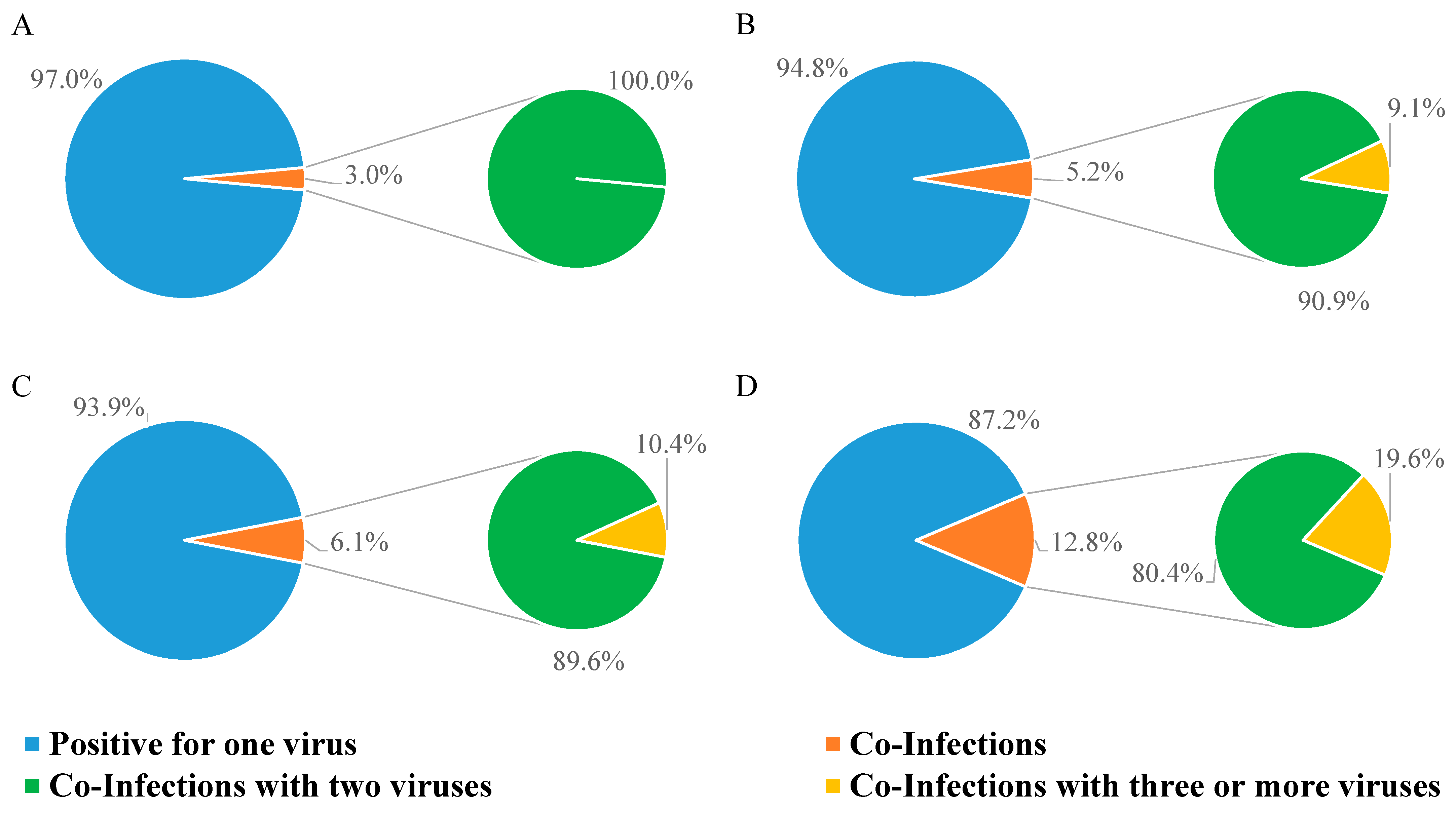A Retrospective Study of Respiratory Viruses in a Four-Year Study of Nasal Swabs from Patients with Severe Influenza-like Symptoms in the Lazio Region, Italy
Abstract
1. Introduction
2. Materials and Methods
2.1. Clinical Specimens and Patients
2.2. Molecular Assays
2.3. Statistical Analysis
3. Results
4. Discussion
5. Limitations of This Study
6. Conclusions
Author Contributions
Funding
Institutional Review Board Statement
Informed Consent Statement
Data Availability Statement
Conflicts of Interest
References
- Ammar, A.; Trabelsi, K.; Brach, M.; Chtourou, H.; Boukhris, O.; Masmoudi, L.; Bouaziz, B.; Bentlage, E.; How, D.; Ahmed, M.; et al. Effects of home confinement on mental health and lifestyle behaviours during the COVID-19 outbreak: Insights from the ECLB-COVID-19 multicentre study. Biol. Sport 2021, 38, 9–21. [Google Scholar] [CrossRef] [PubMed]
- Dipartimento Della Protezione Civile—Governo Italiano. Available online: https://www.protezionecivile.gov.it/it/normativa/dpcm-del-13-ottobre-2020-sulle-misure-di-contrasto-e-contenimento-dell-emergenza-covid-19/ (accessed on 19 February 2025).
- Luštrek, M.; Cesar, Z.; Suljič, A.; Kogoj, R.; Knap, N.; Virant, M.J.; Uršič, T.; Petrovec, M.; Avšič-Županc, T.; Korva, M. Influenza A, Influenza B, human respiratory syncytial virus and SARS-CoV-2 molecular diagnostics and epidemiology in the post COVID-19 era. Respir. Res. 2024, 25, 234. [Google Scholar] [CrossRef]
- Fukuda, Y.; Togashi, A.; Hirakawa, S.; Yamamoto, M.; Fukumura, S.; Nawa, T.; Honjo, S.; Kunizaki, J.; Nishino, K.; Tanaka, T.; et al. Resurgence of human metapneumovirus infection and influenza after three seasons of inactivity in the post-COVID-19 era in Hokkaido, Japan, 2022–2023. J. Med. Virol. 2023, 95, e29299. [Google Scholar] [CrossRef]
- Chow, E.J.; Uyeki, T.M.; Chu, H.Y. The effects of the COVID-19 pandemic on community respiratory virus activity. Nat. Rev. Microbiol. 2022, 21, 195–210. [Google Scholar] [CrossRef]
- Palmas, G.; Trapani, S.; Agosti, M.; Alberti, I.; Aricò, M.; Azzari, C.; Bresesti, I.; Bressan, S.; Caselli, D.; Cazzato, S.; et al. Associazione Ospedali Pediatrici Italiani (AOPI) Network. Disrupted Seasonality of Respiratory Viruses: Retrospective Analysis of Pediatric Hospitalizations in Italy from 2019 to 2023. J. Pediatr. 2024, 268, 113932. [Google Scholar] [CrossRef] [PubMed]
- Sclavi, L.; Bertelli, M.; Messali, S.; Caruso, A.; Caccuri, F. Epidemiology and molecular characterization of respiratory viruses at the end of COVID-19 pandemic in Lombardy, Northern Italy. New Microbiol. 2024, 47, 80–87. [Google Scholar] [PubMed]
- Sberna, G.; Amendola, A.; Valli, M.B.; Carletti, F.; Capobianchi, M.R.; Bordi, L.; Lalle, E. Trend of respiratory pathogens during the COVID-19 epidemic. J. Clin. Virol. 2020, 129, 104470. [Google Scholar] [CrossRef]
- Sberna, G.; Lalle, E.; Valli, M.B.; Bordi, L.; Garbuglia, A.R.; Amendola, A. Changes in the Circulation of Common Respiratory Pathogens among Hospitalized Patients with Influenza-like Illnesses in the Lazio Region (Italy) during Fall Season of the Past Three Years. Int. J. Environ. Res. Public Health 2022, 19, 5962. [Google Scholar] [CrossRef]
- Bordi, L.; Vulcano, A.; Sberna, G.; Nonis, M.; Giacomini, P.; Maggi, F.; Fontana, C.; Lalle, E. Co-Circulation of SARS-CoV-2 and Other Respiratory Pathogens in Upper and Lower Respiratory Tracts during Influenza Season 2022–2023 in Lazio Region. Microorganisms 2023, 11, 2239. [Google Scholar] [CrossRef]
- Santus, P.; Danzo, F.; Signorello, J.C.; Rizzo, A.; Gori, A.; Antinori, S.; Gismondo, M.R.; Branbilla, A.M.; Contoli, M.; Rizzardini, G.; et al. Burden and risk factors for coinfections in patients with a viral respiratory tract infection. Pathogens 2024, 13, 993. [Google Scholar] [CrossRef]
- Mauro, M.V.; Greco, S.; Pellegrini, M.; Campagna, T.; Caprino, F.; Elia, N.; Mastroianni, A.; Greco, F. Epidemiology and clinical impact of single and multi-viral respiratory infections in post-pandemic era. New Microbiol. 2024, 47, 28–32. [Google Scholar]
- The European Respiratory Virus Surveillance Summary (ERVISS). 25 October 2023. Available online: https://www.ecdc.europa.eu/en/publications-data/european-respiratory-virus-surveillance-summary-erviss (accessed on 19 February 2025).
- European Centre for Disease Prevention and Control. Acute Respiratory Infections in the EU/EEA: Epidemiological Update and Current Public Health Recommendations. Available online: https://www.ecdc.europa.eu/en/news-events/acute-respiratory-infections-eueea-epidemiological-update-and-current-public-health (accessed on 19 February 2025).
- Stein, C.; Nassereldine, H.; Sorensen, R.J.D.; Amlag, J.O.; Bisignano, C.; Byrne, S.; Castro, E.; Coberly, K.; Collins, J.K.; Dalos, J.; et al. Past SARS-CoV-2 infection protection against re-infection: A systematic review and meta-analysis. Lancet 2023, 401, 833–842. [Google Scholar] [CrossRef]
- Tu, W.; Zhang, P.; Roberts, A.; Allen, K.S.; Williams, J.; Embi, P.; Grannis, S. SARS-CoV-2 Infection, Hospitalization, and Death in Vaccinated and Infected Individuals by Age Groups in Indiana, 2021–2022. Am. J. Public Health 2023, 113, 96–104. [Google Scholar] [CrossRef]
- Qiagen. Available online: https://www.qiagen.com/us/products/diagnostics-and-clinical-research/infectious-disease/qiastat-dx-syndromic-testing/qiastat-dx-na (accessed on 19 February 2025).
- Biomerieux. Available online: https://www.biomerieux.com/corp/en/our-offer/clinical-products/biofire-respiratory-2-1-panels.html#tabs-8cd7ba93fe-item-51e9655c24 (accessed on 19 February 2025).
- GraphPad. Available online: https://www.graphpad.com/ (accessed on 19 February 2025).
- Mansuy, J.M.; Bourcier, M.; Trémeaux, P.; Dimeglio, C.; Izopet, J. COVID-19 pandemic period, where are the seasonal viruses? J. Med. Virol. 2021, 93, 4097–4098. [Google Scholar] [CrossRef] [PubMed]
- Tang, J.W.; Bialasiewicz, S.; Dwyer, D.E.; Dilcher, M.; Tellier, R.; Taylor, J.; Hua, H.; Jennings, L.; Kok, J.; Levy, A.; et al. Where have all the viruses gone? Disappearance of seasonal respiratory viruses during the COVID-19 pandemic. J. Med. Virol. 2021, 93, 4099–4101. [Google Scholar] [CrossRef] [PubMed]
- De Maio, F.; Fiori, B.; Bianco, D.M.; Sanguinetti, M.; Sali, M. Respiratory viruses in the pre and post-pandemic periods in an Italian tertiary hospital. Immun. Inflamm. Dis. 2023, 11, e909. [Google Scholar] [CrossRef] [PubMed]
- Wang, H.; Zheng, Y.; de Jonge, M.I.; Wang, R.; Verhagen, L.M.; Chen, Y.; Li, L.; Xu, Z.; Wang, W. Lockdown measures during the COVID-19 pandemic strongly impacted the circulation of respiratory pathogens in Southern China. Sci. Rep. 2022, 12, 16926. [Google Scholar] [CrossRef]
- Cho, H.J.; Rhee, J.E.; Kang, D.; Choi, E.H.; Lee, N.J.; Woo, S.; Lee, J.; Lee, S.W.; Kim, E.J.; Yun, K.W. Epidemiology of Respiratory Viruses in Korean Children Before and After the COVID-19 Pandemic: A Prospective Study from National Surveillance System. J. Korean Med. Sci. 2024, 39, e171. [Google Scholar] [CrossRef]
- Jia, W.; Zhang, X.; Sun, R.; Li, P.; Zhen, X.; Li, Y.; Wang, D.; Li, C.; Song, C. Changes in the epidemiological characteristics of influenza in children in Zhengzhou, China, in the post-COVID-19 era. J. Korean Med. Sci. 2024, 39, e171. [Google Scholar] [CrossRef]
- Piret, J.; Boivin, G. Viral Interference between Respiratory Viruses. Emerg. Infect. Dis. 2022, 28, 273–281. [Google Scholar] [CrossRef]
- Waterlow, N.R.; Flasche, S.; Minter, A.; Eggo, R.M. Competition between RSV and influenza: Limits of modelling inference from surveillance data. Epidemics 2021, 35, 100460. [Google Scholar] [CrossRef] [PubMed]
- Wu, A.; Mihaylova, V.T.; Landry, M.L.; Foxman, E.F. Interference between rhinovirus and influenza A virus: A clinical data analysis and experimental infection study. Lancet Microbe 2020, 1, e254–e262. [Google Scholar] [CrossRef] [PubMed]
- Machkovech, H.M.; Hahn, A.M.; Wang, J.G.; Grubaugh, N.D.; Halfmann, P.J.; Johnson, M.C.; Lemieux, J.E.; O’Connor, D.H.; Piantadosi, A.; Wei, W.; et al. Persistent SARS-CoV-2 infection: Significance and implications. Lancet Infect. Dis. 2024, 24, e453–e462. [Google Scholar] [CrossRef] [PubMed]
- Pavia, G.; Quirino, A.; Marascio, N.; Veneziano, C.; Longhini, F.; Bruni, A.; Garofalo, E.; Pantanella, M.; Manno, M.; Gigliotti, S.; et al. Persistence of SARS-CoV-2 infection and viral intra- and inter-host evolution in COVID-19 hospitalized patients. J. Med. Virol. 2024, 96, e29708. [Google Scholar] [CrossRef]
- Babawale, P.I.; Guerrero-Plata, A. Respiratory Viral Coinfections: Insights into Epidemiology, Immune Response, Pathology, and Clinical Outcomes. Pathogens 2024, 13, 316. [Google Scholar] [CrossRef]



| Semester | Examined | |||
|---|---|---|---|---|
| Total n. | n. Female (%) | n. Male (%) | Median Age (95% CI) * | |
| 1° 2021 | 913 | 366 (40) | 547 (60) | 64 (62–66) |
| 2° 2021 | 466 | 192 (41) | 274 (59) | 57 (53–59) |
| 1° 2022 | 432 | 178 (41) | 254 (59) | 70 (68–72) |
| 2° 2022 | 423 | 184 (43) | 239 (57) | 69 (65–70) |
| 1° 2023 | 666 | 294 (44) | 372 (56) | 69 (67–71) |
| 2° 2023 | 490 | 213 (43) | 277 (57) | 58 (56–61) |
| 1° 2024 | 640 | 240 (37) | 400 (63) | 56 (53–60) |
| 2° 2024 | 1052 | 451 (43) | 601 (57) | 49 (46–52) |
| Total | 5082 | 2118 (42) | 2964 (58) | 61 (60–62) |
| Year | Total n. | Patients n. with Information (%) | Department | Patients n. (%) |
|---|---|---|---|---|
| 2021 | 1379 | 478 (35) | ICU * | 135 (28) |
| GHW # | 343 (72) | |||
| 2022 | 855 | 377 (44) | ICU | 162 (43) |
| GHW | 215 (57) | |||
| 2023 | 1156 | 464 (40) | ICU | 90 (19) |
| GHW | 374 (81) | |||
| 2024 | 1692 | 467 (28) | ICU | 43 (9) |
| GHW | 424 (91) | |||
| Total | 5082 | 1786 (35) | ICU | 430 (24) |
| GHW | 1356 (76) |
| Year | Examined | n. Positive (%) |
|---|---|---|
| 2021 | 1379 | 727 (53) a |
| 2022 | 855 | 445 (52) b |
| 2023 | 1156 | 506 (44) |
| 2024 | 1692 | 720 (43) |
| Total | 5082 | 2398 (47) |
| Years | GHW | ICU |
|---|---|---|
| 2021 | 80.0% | 20.0% |
| 2022 | 58.3% | 41.7% |
| 2023 | 66.7% | 33.3% |
| 2024 | 93.7% | 6.3% |
| 2021 | 2022 | 2023 | 2024 | |
|---|---|---|---|---|
| SARS-CoV-2 | 57.9% | 68.8% | 40.0% | 13.9% |
| HRV/EV | 57.9% | 37.5% | 56.0% | 80.2% |
| HPIV | 10.5% | 12.5% | 12.0% | 22.1% |
| FLUAV + FLUBV | 21.0% | 25.0% | 12.0% | 19.8% |
| HAdV | 0.0% | 0.0% | 12.0% | 31.4% |
| HCoV (non-SARS-CoV-2) | 15.8% | 25.0% | 20.0% | 16.3% |
| HMPV | 15.8% | 12.5% | 24.0% | 8.1% |
| HRSV | 21.0% | 18.8% | 32.0% | 30.2% |
Disclaimer/Publisher’s Note: The statements, opinions and data contained in all publications are solely those of the individual author(s) and contributor(s) and not of MDPI and/or the editor(s). MDPI and/or the editor(s) disclaim responsibility for any injury to people or property resulting from any ideas, methods, instructions or products referred to in the content. |
© 2025 by the authors. Licensee MDPI, Basel, Switzerland. This article is an open access article distributed under the terms and conditions of the Creative Commons Attribution (CC BY) license (https://creativecommons.org/licenses/by/4.0/).
Share and Cite
Sberna, G.; Bordi, L.; Mija, C.; Girardi, E.; Maggi, F.; Lalle, E. A Retrospective Study of Respiratory Viruses in a Four-Year Study of Nasal Swabs from Patients with Severe Influenza-like Symptoms in the Lazio Region, Italy. Viruses 2025, 17, 452. https://doi.org/10.3390/v17030452
Sberna G, Bordi L, Mija C, Girardi E, Maggi F, Lalle E. A Retrospective Study of Respiratory Viruses in a Four-Year Study of Nasal Swabs from Patients with Severe Influenza-like Symptoms in the Lazio Region, Italy. Viruses. 2025; 17(3):452. https://doi.org/10.3390/v17030452
Chicago/Turabian StyleSberna, Giuseppe, Licia Bordi, Cosmina Mija, Enrico Girardi, Fabrizio Maggi, and Eleonora Lalle. 2025. "A Retrospective Study of Respiratory Viruses in a Four-Year Study of Nasal Swabs from Patients with Severe Influenza-like Symptoms in the Lazio Region, Italy" Viruses 17, no. 3: 452. https://doi.org/10.3390/v17030452
APA StyleSberna, G., Bordi, L., Mija, C., Girardi, E., Maggi, F., & Lalle, E. (2025). A Retrospective Study of Respiratory Viruses in a Four-Year Study of Nasal Swabs from Patients with Severe Influenza-like Symptoms in the Lazio Region, Italy. Viruses, 17(3), 452. https://doi.org/10.3390/v17030452







